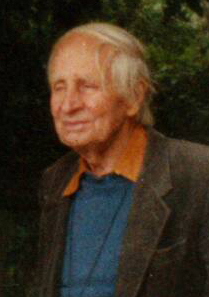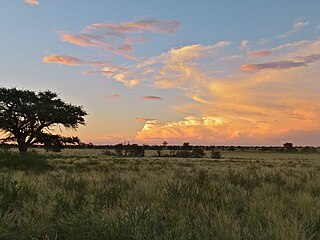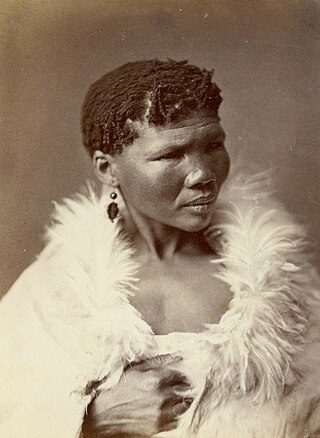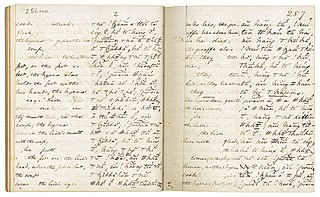
Wilhelm Heinrich Immanuel Bleek was a German linguist. His work included A Comparative Grammar of South African Languages and his great project jointly executed with Lucy Lloyd: The Bleek and Lloyd Archive of ǀxam and !kun texts. A short form of this eventually reached press with Specimens of Bushman Folklore, which Laurens van der Post drew on heavily.

The San peoples, or Bushmen, are the members of the indigenous hunter-gatherer cultures of southern Africa, and the oldest surviving cultures of the region. Their ancestral territories span Botswana, Namibia, Angola, Zambia, Zimbabwe, Lesotho and South Africa. They speak, or their ancestors spoke, languages of the Khoe, Tuu and Kxʼa language families, and are only a 'people' in contrast to pastoralists such as the Khoekhoe and descendants of more recent waves of immigration such as the Bantu, Europeans and Asians.
ǀXam is an extinct language of South Africa formerly spoken by the ǀXam-ka ǃʼē. It is part of the ǃUi branch of the Tuu languages and closely related to the moribund Nǁng language. Much of the scholarly work on ǀXam was performed by Wilhelm Bleek, a German linguist of the 19th century, who studied a variety of ǀXam spoken at Achterveld, and another spoken at Strandberg and Katkop while working with ǁKábbo, Diaǃkwāin, ǀAǃkúṅta, ǃKwéite̥n ta ǁKēn, ǀHaṅǂkassʼō and other speakers. The surviving corpus of ǀXam comes from the stories told by and vocabulary recorded from these individuals in the Bleek and Lloyd Collection.

Sir Laurens Jan van der Post, was a South African Afrikaner writer, farmer, soldier, educator, journalist, humanitarian, philosopher, explorer and conservationist. He was noted for his interest in Jungianism and the Kalahari Bushmen, his experiences during World War II, as well as his relationships with notable figures such as the future King Charles III and British Prime Minister Margaret Thatcher. After his death, there was controversy over claims that he had exaggerated many aspects of his life, as well as his sexual abuse and impregnation of a 14-year-old girl.
Sympathetic magic, also known as imitative magic, is a type of magic based on imitation or correspondence.

Specimens of Bushman Folklore is a book by the linguist Wilhelm H. I. Bleek and Lucy C. Lloyd, which was published in 1911. The book records eighty-seven legends, myths and other traditional stories of the ǀXam Bushmen in their now-extinct language. The stories were collected through interviews with various narrators, chief among them ǀA!kunta, ǁKabbo, Diäǃkwain, !Kweiten-ta-ǀǀKen and ǀHanǂkasso.

The Iziko South African Museum is a South African national museum located in Cape Town. The museum was founded in 1825, the first in the country. It has been on its present site in the Company's Garden since 1897. The museum houses important African zoology, palaeontology and archaeology collections.

Lucy Catherine Lloyd was the creator, along with Wilhelm Bleek, of the 19th-century archive of ǀXam and !Kung texts.

James David Lewis-Williams is a South African archaeologist. He is best known for his research on southern African San (Bushmen) rock art. He is the founder and previous director of the Rock Art Research Institute and is currently professor emeritus of cognitive archaeology at the University of the Witwatersrand (WITS).
In the culture of the San, an indigenous people of Botswana, Namibia, South Africa, and Angola, healers administer a wide range of practices, from oral remedies containing plant and animal material, making cuts on the body and rubbing in 'potent' substances, inhaling smoke of smouldering organic matter like certain twigs or animal dung, wearing parts of animals or 'jewellery' that 'makes them strong.' Anecdotal records reveal that the Khoikhoi and San people have used Sceletium tortuosum since ancient times as an essential part of the indigenous culture and materia medica. The trance dance is one of the most distinctive features of San culture.
ǀKaggen pronounced IPA:[ǀ͡Kaggen] is a demiurge and folk hero of the San people of southern Africa. He is a trickster god who can shape shift, usually taking the form of a praying mantis but also a bull eland, a louse, a snake, and a caterpillar.

The ǀXam and ǂKhomani heartland World Heritage Site consists of regions located to the South and North of Upington, respectively, in the Northern Cape Province of South Africa. The ǀXam and ǂKhomani people were linguistically related groups of San (Bushman) people, their respective languages being part of the ǃKwi language group. Descendants of both the ǀXam and Nǁnǂe include Afrikaans-speaking ‘Coloured’ people on farms or in towns in the region amongst whom the precolonial languages are either entirely extinct or can be spoken by but a very few people.
Driekops Eiland is a rock engraving or petroglyph site in the bed of the Riet River close to the town of Plooysburg, near Kimberley, Northern Cape, South Africa.
Wildebeest Kuil Rock Art Centre is a rock engraving site with visitor centre on land owned by the !Xun and Khwe San situated about 16 km from Kimberley, Northern Cape, South Africa. It is a declared Provincial Heritage Site managed by the Northern Cape Rock Art Trust in association with the McGregor Museum. The engravings exemplify one of the forms often referred to as ‘Bushman rock art' – or Khoe-San rock art – with the rock paintings of the Drakensberg, Cederberg and other regions of South Africa being generally better known occurrences. Differing in technique, the engravings have many features in common with rock paintings. A greater emphasis on large mammals such as elephant, rhino and hippo, in addition to eland, and an often reduced concern with depicting the human form set the engravings apart from the paintings of the sub-continent.

The Mind in the Cave: Consciousness and the Origins of Art is a 2002 study of Upper Palaeolithic European rock art written by the archaeologist David Lewis-Williams, then a professor at the University of the Witwatersrand in Johannesburg, South Africa.

Dorothea Frances Bleek was a South African-born German anthropologist and philologist known for her research on the Bushmen of southern Africa.

The San, or Bushmen, are indigenous people in Southern Africa particularly in what is now South Africa and Botswana. Their ancient rock paintings and carvings are found in caves and on rock shelters. The artwork depicts non-human beings, hunters, and half-human half-animal hybrids. The half-human hybrids are believed to be medicine men or healers involved in a healing dance. A painting discovered at Blombos Cave is thought to be the oldest known instance of human art, dating to around 73,000 years ago. Gall writes, “The Laurens van der Post panel at Tsodilo is one of the most famous rock paintings.” High on this rock face in Botswana is the image of a “magnificent red eland bull” painted, according to Van der Post, “only as a Bushman who had a deep identification with the eland could have painted him.” Also on this rock face is a female giraffe that is motionless, as if alarmed by a predator. Several other images of animals are depicted there, along with the flesh blood-red handprints that are the signature of the unknown artist. The Drakensberg and Lesotho are particularly well known for their San rock art. Tsodilo was recognised as a UNESCO World Heritage Site in 2001; not all the art covered by this is by San people or their ancestors.
Patricia Joan Vinnicombe was a South African archaeologist and artist, known for identifying and copying San rock paintings in the valleys and foothills of the Drakensberg. Her work transformed the study of rock art into a science. She was also active in the preservation of Aboriginal art in Western Australia.

ǃKweiten-ta-ǁKen was a noted ǀXam (San) chronicler of ǀXam culture and knowledge. She played an important role in contributing to the Bleek and Lloyd archive of "Specimens of Bushman Folklore" providing a female perspective on the life, rituals, and beliefs of |Xam society. She was the primary source on ǀxam folklore, customs, and coming-of-age rites. She travelled to the Cape in June 1874 with her family and stayed until January 1875 during which she was interviewed by Wilhelm Bleek and Lucy Lloyd. She was from the Katkop mountains north west of Brandvlei in what is today South Africa.

ǁKábbo was a noted ǀXam chronicler of ǀXam culture and knowledge. He played an important role in contributing to the Bleek and Lloyd archive of “Specimens of Bushman Folklore” providing the life, rituals, and beliefs of ǀXam society.















